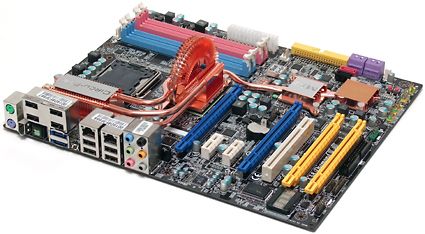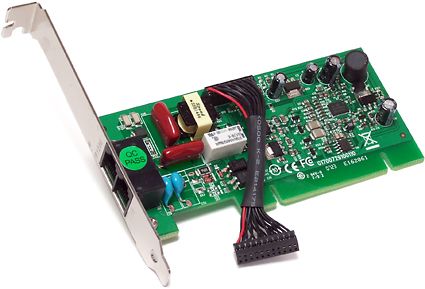X38 Comparison Part 2: DDR3 Motherboards
MSI X38 Diamond
MSI's Diamond series is all about "one-upping" the competition in terms of both features and performance, and its latest iteration is no exception.
Best known for producing lower-cost performance boards, MSI uses its upscale Diamond series to prove it can outclass even the best of boards. The latest example starts off with not two, but four PCI Express x16 slots, to allow a possible "QuadFire" setup of ATI graphics cards.
The only problem with supporting four graphics cards is that the X38 Express chipset is only designed to support two! The top two PCI Express slots provide the full sixteen pathways plus bandwidth-doubling PCI Express 2.0 compatibility, while the lower two x16 slots use standard x4 pathways. A PCI Express hub located beneath the ICH9R Southbridge makes it all work together.
The odd looking panel behind the two yellow PCI Express slots is a 4-character LED system status display, which beats two-digit numeric POST code displays by showing the system status in abbreviated English words. It's also eye-piercingly bright!
The X38 Diamond is the only board in this review to have its uppermost PCI Express x16 slot located in the traditional top position, which forces the DIMM slots to the very top of the board. It still has some room to install and remove memory with a long graphics card in place, but lacks the northbridge to DIMM centering that other designs use to reduce memory trace length for increased high-speed stability.
Taking a step back to problems of the past is a floppy connector at the bottom of the board, beneath the lowest PCI Express x16 slot. While most builders wouldn't care about this, those who use old-fashioned floppy drives to load AHCI or RAID drivers during Windows XP installation will likely have trouble routing the cable to their drive.
MSI also faces the Ultra ATA and four of its six internal Serial ATA connectors toward the front edge of the X38 Diamond, which could cause cable installation issues in cases that have the lower drive cage mounted closely to the board's front edge. The other two Serial ATA ports face upward, but could potentially be blocked off by the coolers of long graphics cards.
Get Tom's Hardware's best news and in-depth reviews, straight to your inbox.
MSI moves the front-panel audio connector for its onboard codec to the center of the rear edge, which allows easier cable routing to top-mounted "front panel" bays, but also includes an add-in audio card which could make the onboard connector unnecessary.
An eight-phase CPU voltage regulator beats the six phases of the Foxconn X38A, and matches the eight phases of the Asus Maximus Extreme, but falls a little short of the twelve phases of Gigabyte's GA-X38T-DQ6. Our tests showed excellent voltage stability.
Power cable connections are adequately placed for a short path to any top-mounted power supply, but for the sake of Windows XP drive controller drivers we'd have rather seen the floppy connector where the 24-pin ATX/EPS main power is located.
Handy but not-so-noticeable are power and reset buttons near the bottom front corner, which make bench testing of an uninstalled board easy.
| MSI X38 Diamond (Revision 1.0) | |
|---|---|
| Northbridge | Intel X38 Express MCH |
| Southbridge | Intel ICH9R |
| Voltage Regulator | Eight Phases |
| BIOS | D24 (11/02/2007) |
| 333.3 MHz (FSB1333) | 333.3 MHz (+0.0%) |
| Connectors and Interfaces | |
| Onboard | 4x PCIe x16 (Two with x4 pathways)2x PCIe x11x PCI2x USB 2.0 (2 ports per connector)1x IEEE-1394 Header1x Serial Port Header1x Floppy1x Ultra ATA (2 drives)6x Serial ATA 3.0Gb/s1x Front Panel Audio1x CD-Audio In1x VoIP interface connector2x Fan 4 pins (CPU/System)4x Fan 3 pins (System)1x Internal Power Switch1x Internal Reset Switch |
| IO panel | 2x PS2 (keyboard + mouse)2x RJ-45 Network8x USB 2.06x Analog Audio (7.1 Channel + Mic-In + Line-In)2x Digital Audio (S/P-DIF Optical+Coaxial)2x eSATA (External Serial ATA) interface1x CLR_CMOS Button |
| Mass Storage Controllers | |
| Intel ICH9R | 6x SATA 3.0 Gb/s (RAID 0,1,5,10) |
| Marvell 88SE6111 | 1x Ultra ATA-100 (2-drives)2x SATA 3.0 Gb/s |
| Network | |
| Realtek RTL811B PCI-E | 1x Gigabit LAN Connection |
| Intel 82566DC (GLCI) PHY | 1x Gigabit LAN Connection |
| Audio | |
| HDA (Azalia) Controller Interface | Realtek ALC888T 8+2 Ch. +VoIP Codec |
| FireWire | |
| VIA VT6308P | 2x IEEE-1394a (400 Mbit/s) |
MSI uses the Marvell 88SE6111 controller to add Ultra ATA capability to the ICH9R southbridge, while also adding two eSATA ports through a Silicon Image SII5723CNU SATA to eSATA adapter. Though these choices seem a little unusual compared to those made by competing models, MSI's use of Intel's proprietary 824566DC Gigabit Ethernet LAN PHY seems almost ingenious, as it reduces reliance on the limited number of PCI Express pathways.
The Realtek ALC888T provides ten channels to multi-stream separate 7.1 and 2-channel audio to rear and front panel connectors. Its primary function in the X38 Diamond is to provide a connection for MSI's VoIP-to-telephone adapter, however, as its 97 dB signal-to-noise ratio is beaten rather easily by an included X-Fi Xtreme Audio card.
Rear panel ports include eight USB 2.0 and two External SATA in addition to the expected PS/2 keyboard and mouse, IEEE-1394 FireWire, digital audio (optical), and dual Gigabit Ethernet. Six analog jacks address the onboard controller's 7.1-channel capability without sacrificing rear-panel inputs, but it's questionable as to why MSI would bother with these when it also includes a discrete audio card.
Also found but barely seen on the rear panel is a CLR_CMOS jumper. It's good that this connector is hard to spot, since we didn't see any way to disable its function.
The SkyTel VoIP card allows any landline telephone to be used with Skype, while a second jack also allows incoming landline calls to be passed to the same phone. It certainly looks like a PCI modem, but the edge has no data pins; instead, an interface cable plugs into a custom jack located beneath the motherboard's bottom slot. The card might not use the PCI slot for anything other than mechanical support, but it certainly blocks any other card from being inserted there.
The X-Fi Xtreme Audio card is a simplified PCI Express x1 part without the famed X-Fi DSP. It compares to similar PCI interface X-Fi cards typically priced around $50-60. Unlike many of Creative Labs' retail models, this OEM design supports standard front panel audio cables.




